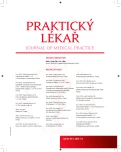-
Medical journals
- Career
Patient with abdominal aortic aneurysm – diagnostics, follow-up and treatment in the ambulance of general practitioner
Authors: L. Kubíček; R. Staffa
Authors‘ workplace: Přednosta: prof. MUDr. Robert Staffa, Ph. D. ; Centrum cévních onemocnění ; Fakultní nemocnice u sv. Anny v Brně a Lékařská fakulta Masarykovy univerzity ; II. chirurgická klinika
Published in: Prakt. Lék. 2015; 95(6): 283-287
Category: Of different specialties
Overview
Introduction:
Incidence of patients with abdominal aortic aneurysm is continually rising and in the case of its rupture the mortality rate remains still very high. General practitioner is the first who can diagnose aneurysm’s presence by clinical examination of a risk population, primarily elder male smokers with hypertension. The goal of this paper is to summarize up to date knowledge of AAA both from available literature and from the experience of centre for vascular surgery and create a brief recommendations for general practitioners.Patients:
During the years 2010–2015 we performed 144 elective interventions for asymptomatic AAA (117 open repairs and 27 endovascular procedures) and 80 urgent open repairs for ruptured AAA.Results:
The mortality rate in our patients with AAA rupture was 48.8%, however the mortality after an elective intervention was 4.3% only. There was a clear predominance of males both in the set of ruptured AAA (80.0%) and elective interventions (83.3%). The most important risk factor either for aneurysm development or its rupture is hypertension, which was presented in the vast majority of patients. Interesting outcome is the distribution of rupture count into a particular months; the biggest concentration of aneurysm ruptures was presented in the period from april to july.Discussion:
Due to absence of national ultrasound screening program in the Czech Republic, the ambulance of general practitioner is the first place, where a part of asymptomatic AAA can be detected by a quick physical examination of the risk patients (male older than 65 years, smoker, hypertension) and consequent ultrasound examination. Crucial for a patient with AAA is strict hypertension treatment, because hypertension is the main risk factor for aneurysm rupture. General practitioner should frequently monitor patient´s blood pressure and eventually correct patient´s anti-hypertensive medication. After a successful intervention the general practitioner is usually the first who can detect potential complications, therefore these should be kept in mind and general practitioner should closely cooperate with a centre for vascular surgery. Mutual cooperation is the key to detection of higher number of asymptomatic AAA and successful treatment.Keywords:
abdominal aortic aneurysm – rupture – dispensarization – risk factors
Sources
1. Best VA, Price JF, Fowkes FG. Persistent increase in the incidence of abdominal aortic aneurysm in Scotland, 1981–2000. Br J Surg 2003; 90(12): 1510–1515.
2. Filipovic M, Goldacre MJ, Roberts SE, et al. Trends in mortality and hospital admission rates for abdominal aortic aneurysm in England and Wales, 1979–1999. Br J Surg 2005; 92(8): 968–975.
3. Derubertis BG, Trocciola SM, Ryer EJ, et al. Abdominal aortic aneurysm in women: Prevalence, risk factors, and implications for screening. J Vasc Surg 2007; 46(4): 630–635.
4. Liapis C, Sechas M, Iliopoulos D, et al. Seasonal variation in the incidence of ruptured abdominal aortic-aneurysm. Eur J Vasc Surg 1992; 6(4): 416–418.
5. Mureebe L, Egorova N, McKinsey JF, Kent KC. Gender trends in the repair of ruptured abdominal aortic aneurysms and outcomes. J Vasc Surg 2010; 51(Suppl 4): 9S–S13.
6. Kent KC, Zwolak RM, Egorova NN, et al. Analysis of risk factors for abdominal aortic aneurysm in a cohort of more than 3 million individuals. J Vasc Surg 2010; 52(3): 539–548.
7. Brown LC, Powell JT. Risk factors for aneurysm rupture in patients kept under ultrasound surveillance. Ann Surg 1999; 230(3): 289–296.
8. The UK Small Aneurysm Trial Participants. Mortality results for randomised controlled trial of early elective surgery or ultrasonographic surveillance for small abdominal aortic aneurysms. Lancet 1998; 352(9141): 1649–1655.
9. Giles KA, Pomposelli F, Hamdan A, et al. Decrease in total aneurysm-related deaths in the era of endovascular aneurysm repair. J Vasc Surg 2009; 49(3): 543–551.
10. Moll FL, Powell JT, Fraedrich G, et al. Management of abdominal aortic aneurysms clinical practice guidelines of the European society for vascular surgery. Eur J Vasc Endovasc Surg 2011; 41(Suppl 1): S1–S58.
11. Health Quality Ontario. Ultrasound screening for abdominal aortic aneurysm: an evidence-based analysis. Ont Health Technol Assess Ser 2006; 6(2): 1–67.
12. Dawson J, Fitridge R. Update on aneurysm disease: current insights and controversies peripheral aneurysms: when to intervene – is rupture really a danger? Prog Cardiovasc Dis 2013; 56(1): 26–35.
Labels
General practitioner for children and adolescents General practitioner for adults
Article was published inGeneral Practitioner

2015 Issue 6-
All articles in this issue
- Betaglucans – immunomodulatory substances in prevention and support treatment
- Gastric surgery at present
- Malignant tumours – strategy and preventive programmes in the Czech Republic
- Opinions and attitudes of Czech citizens on the issue of health and healthy lifestyles
- How to fulfil a legal duty to inform patient writing his/her previous expressed wish?
- Commission health assessment by medical assessor committees
- Psychological aspects of malignant vasovagal syncopes
- Changes in body composition and eating habits of obese patients after intragastric balloon insertion
- The reliability of the Czech version of the General-Food Craving Questionnaire-Trait
- Patient with abdominal aortic aneurysm – diagnostics, follow-up and treatment in the ambulance of general practitioner
- General Practitioner
- Journal archive
- Current issue
- Online only
- About the journal
Most read in this issue- Gastric surgery at present
- Betaglucans – immunomodulatory substances in prevention and support treatment
- Commission health assessment by medical assessor committees
- Patient with abdominal aortic aneurysm – diagnostics, follow-up and treatment in the ambulance of general practitioner
Login#ADS_BOTTOM_SCRIPTS#Forgotten passwordEnter the email address that you registered with. We will send you instructions on how to set a new password.
- Career

